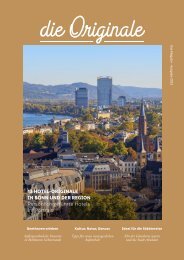LUXAIR_LUXiClub_So12 ls
p o
p
o
You also want an ePaper? Increase the reach of your titles
YUMPU automatically turns print PDFs into web optimized ePapers that Google loves.
Number 43, Fall 2002
cartographic perspectives 39
Figure 17. The same hillshaded map in Figure 15 dithered with the halftone patterns from Figure 9
oriented in the aspect direction.
at the resolution of the input data, while matching classes of gray determined
by hillshading.
Creating accurate hillshaded maps with continuous shades of gray has
twice been a goal of cartographers, first with hand-rendered and then
with computer-generated maps. The computer reproduction technique of
halftoning adds a new control to shading. Halftones, the elemental building
block of computer hardcopy displays, can be used to create a pattern,
while maintaining the grayscales determined from hillshading.
The author welcomes users to experiment with this method and the resulting
images. Copies of the bitmaps used for Figures 7, 9 and 10 and the
ESRI ArcView legend files (.avl extension) used to create Figures 16, 17,
and 18 can be downloaded from http://www.mbmg.mtech.edu/gis_hillshading.htm.
This website also includes GIS based methods for automating
the methods of hachure mapping and those developed by Tanaka
(1932 and 1950) that are discussed in this paper. For other recent applications
of hillshading methods, see the NACIS Shaded Relief Homepage
maintained by Tom Patterson at http://www.nacis.org/cp/cp28/resources.html.
The author would like to thank Dr. Robert Ulichney, Dr. Kenneth Sloan,
and Vincent Cotter for early comments and suggestions on this halftoning
method, and Dr. Jon Kimerling for his perusal of the initial manuscript.
Thanks also to Cartographic Perspectives editor Dr. Scott Freundschuh and
ONLINE RESOURCES
ACKNOWLEDGEMENTS















